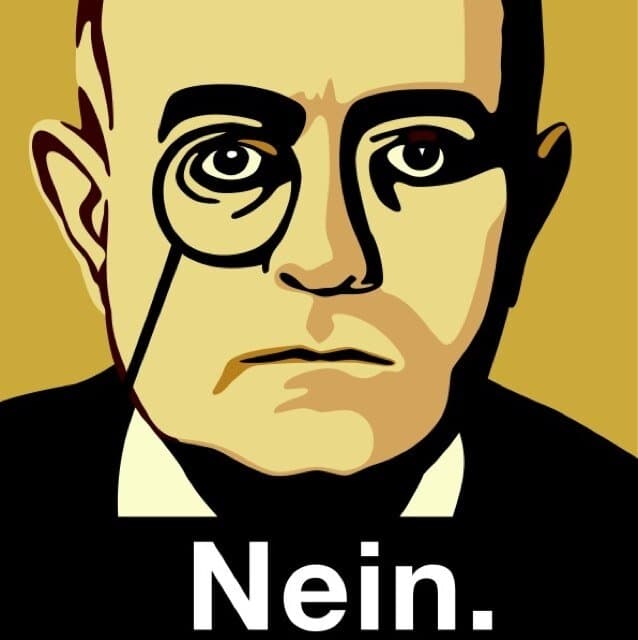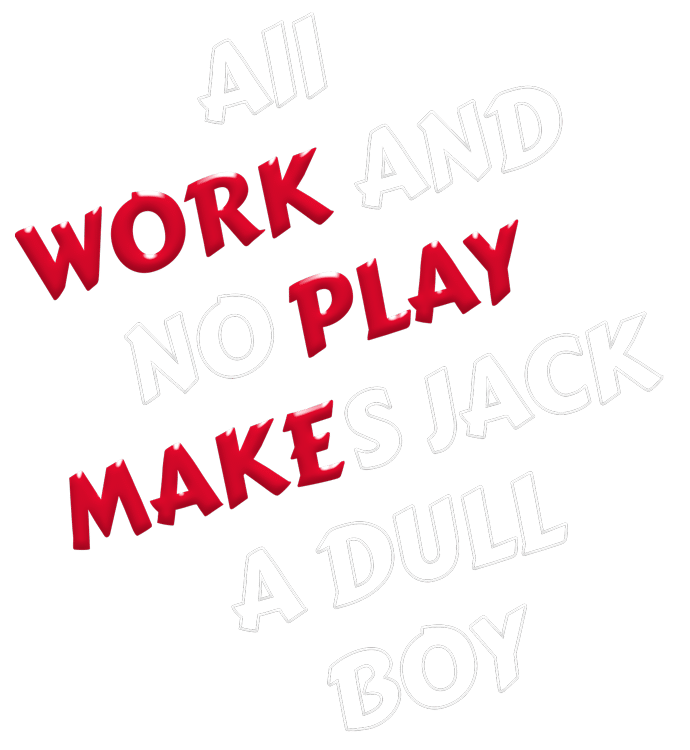
If you are on Twitter, you might know @NeinQuarterly – a slightly pessimistic, whimsical cynic with a soft spot for Theodor W. Adorno and German Umlaute. With his witty aphorisms on European culture, critical theory and the German language, he has gained more followers than the avarage intellectual misanthrope can handle. A quick internet search for the man behind the Nein servers brought us Eric Jarosinski, a surprisingly charming, non-monocled professor of German at the University of Pennsilvania in Philadelphia. Our friend and interview whizz kid Juliane Liebert talked to him about his academic work, Berlin and the Ü.
It’s really early where you are, right?
Oh, no. Not for a Saturday. It‘s eleven in the morning. So you want to ask me some questions about … about ME?
Haha. Yes. So one of your topics is the rhetorical construction of Nazi Berlin. What‘s that?
Well the book I’ve been writing is about transparency as a metaphor in architecture, essentially architecture built in Berlin since 1989, most famously the Reichstag Cupola, for instance. In doing my background research, I became interested in a number of propaganda texts about Berlin from the Nazi era. Largely books and pamphlets about the city’s supposed transformation under the Nazis, turning it into a representation of a certain Germanic essence. There are a lot of metaphors related to transparency from that time. Goebbels, for instance, talks about the city becoming clearly ordered and readily comprehensible, as if seen through glass. That’s interesting, because now transparency is used to represent openness, democracy, freedom, and coming to terms with the past … and it’s striking to see how the same metaphor has been used in different ways over time in order to serve vastly different agendas.
There are also a lot of volumes of illustrated books for visitors to Berlin from the 1930s, a kind of Nazi-tourist culture. They are about what to see, but also about how to see it. There are for example maps of the city with indications where early members of the Nazi party died in street fights …
Really?
Yeah, one of the most interesting books I found was called Wir Wandern durch das Nationalsozialistische Berlin and it is the story of the city as told from this perspective. I’ve lived in Berlin for a couple of years, so I knew some of the places mentioned in the book, but it was interesting to see them from this highly ideological point of view. I am not a trained architect, but I have a real interest in how architecture is written about and how it is instrumentalized in the name of a cultural or political agenda.
So you have lived in Berlin?
Yes, I‘ve lived in many different parts of the city. The longest stretch was almost two years, and I‘ve moved probably six or seven times. I was just subletting places, and it was always just a shorter period of time. I only had two suitcases, so it also made it possible to move with just a taxi and to get to know daily life in various neighborhoods. The city became really big for me then, I had my barber in Neukölln, and I had my cleaner in Prenzlberg – just everyday things you’d usually do in one part of the city spread out, because I developed a relationship to those little things in various parts of the city. But I really benefitted from that. It became clear to me that even in the largest city you can restrict yourself to pretty small corners of the place, just because you have your routines.
What did you do?
I was working on my dissertation, so I was able to focus on my research and writing. I consider myself very fortunate to have had that amount of time. There‘s a lot of pressure in the American academic system and increasingly in the German one, too, to rush through graduate programs. To actually get a chance to do things at a slower pace but in a meaningful way really mattered to me. For me the experience more than anything has been the pleasure that I‘ve taken in discovering new things, but primarily new things within the context of the everyday. I also tell my students that they should study abroad, because if you’re just a tourist somewhere, you‘ll never know that experience. Which is one of being at a place long enough to hate it, and then to love it, and then to hate it and then to love it … you know, to first have difficulties, then have things work out–that‘s the great value, more than anything else. Berlin is diverse enough to allow for many different ways of being and of living, with very different circles one can get acquainted with.
What’s a typical way if somebody from the US, for example your students, would speak about Berlin or Germany now?
It’s difficult to generalize, but one things I’ve noticed is that they might have very different associations with Germany than they do with Berlin. People might have a lot of negative expectations about Germany, but very positive ones about Berlin … and when they spend time there they have to realise that those things belong together. Berlin is not some little town in the Bavarian Hinterland, of course. It has a connection to a larger culture, right? It‘s a place with all these cool, unique things, yet at the same time you also often find yourself doing these stereotypical German things, like waiting for the red light to change. I didn‘t come to Berlin with quite the same background. I’d lived in a few other places in Germany first. For me that was good preparation. I had an idea of what the culture was like in general and could then enjoy the more distinctive things about Berlin.
Although it is really ugly if we‘re honest, huh?
Maybe. That’s the interesting thing about it. People expect Berlin to be more on the order of Paris or Rome, in terms of monumental architecture, for instance, but that’s not really what Berlin is about, at least not for me. I stopped thinking about cities in terms of beautiful or not beautiful a long time ago.
What’s your interest in the Nazi era?
The thing I’m really interested in is actually the period from 1900 to the late 1920s, early 1930s, but I’ve become more interested in the Nazi era because lots of the things I’ve read and written about have a certain afterlife in that period. I‘ve been led there more historically than anything else. What always comes up in teaching is underlining the importance of Germany’s Nazi past in terms of its presence today–without letting that overshadow everything else.
Yes, people forget that all the time.
Yeah, that’s just the way it works. It’s not new or surprising. To me that’s the interesting thing about doing more historical work. It‘s about reminding yourself of that, and reminding yourself of the conclusions you’ve drawn, and the things that have become so natural to you but were not inevitable. I was recently teaching a Nietzsche course, so I‘m thinking a lot about history, looking at how morality or notions of social order emerged culturally and historically, and how they could have emerged differently, but also the ways how we impose a certain logic or explanation upon these things that are serving different agendas again. What I’m trying to teach is that element of debate, of disagreement and certainly of contested positions. Germany has a really vibrant culture of debate, I think, not least because of its history.
What‘s the worst thing about learning German?
People find the grammar really hard. But they probably just don‘t have a good teacher. I make a lot of jokes about the difficulty of German grammar, although I don‘t really believe in it. It has a reputation of being a very harsh language, that it’s not a beautiful language, and that’s something I play with on my Twitter feed. Because again, just like I don’t think of Berlin as being a beautiful or a ugly city, that‘s also not how I think about languages. For me it is really interesting to just listen to the way German native speakers speak and the way the language is constantly changing.
… and how do they speak?
Well, I pay attention to regional differences, choice of words, listening for expressions that maybe I wanna pick up. That to me is the fun of being outside your own culture. The everyday becomes so much more interesting. A conversation on the train that might be annoying to you at home, is then an opportunity to overhear somebody‘s colorful use of language… How does one person work with this language that I‘ve learnt as an outsider, how does someone who grew up with it, use it, play with it, make it their own. I‘ve learned the most about German from friends of mine, because of the distinctive ways that they use it. I‘m often never sure if this is an expression that everyone knows or just one of the many Stefans I know (Everyone male in their late thirties, early forties seems to be named Stefan, right?!). The development of the language that we use has become a distinctive part of our friendship. There’s a history to the way we talk to each other, and that‘s something that I really like.
You’re spending a lot of time on Twitter, tweeting as Nein Quartely …
This twitter thing, as silly as it is most of the time, does provide an opportunity for me to really think about a lot of these things in a much more conscious way … about what I can do with German or with a specific expression. What I like about it most is the unexpected discovery of a connection between words, some play on words or just a relationship that one wouldn’t have otherwise – mainly because when you‘re dealing with such a small amount of text, you get to know it differently, more closely.
You’re obsessed with Umlaute?
Well, thats part of the Twitter persona I’ve developed, but yes.
So Nein Quartely is a kind of character?
Yes, not only, but largely. It’s loosely based on one of the philosophers I work with… you know Theodor W. Adorno?
Sure. But he wasn’t obsessed with Umlaute!
Perhaps not, but he did write an essay on punctuation marks…
So whats your favorite Umlaut?
Ü!
And why?
… Why? It’s interesting. You can do a lot with it. I mean, it’s a really banal thing, but the Ü is a smiley face, right? And its also interesting because I have this obsession … I mean, you know how little text you have in a tweet? So I pay attention to the characters, I even pay attention sometimes to what they look like. Calling attention to an Umlaut is taking something that is easily identifiable as German, but than making something playful out of it.
Haha. Thank you.

8 Responses
Excellent and one of the best posts I’ve seen in a long time (including mine). I would like permission to reprint it on my blog if you would be so kind. Please feel free to stroll by there first and check it out if you prefer. Thanks.
hi Charlie! glad that you like it! sure, feel free to repost it – a link back to our blog and we’re fine!